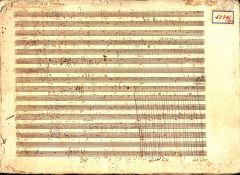Ignaz Joseph Pleyel’s Violone Concerto Identified
Darija Andelic-Andzakovic
Thursday, September 25, 2025

We have received the following from Darija Andelic-Andzakovic (musicologist and double bass player).
Johannes Mathias Sperger (Feldsberg/Valtice, 1750 – Ludwigslust, 1812) is widely known as the composer of 18 concertos for double bass. Sperger’s concertos survive in autograph scores as part of his estate housed at the Landesbibliothek Mecklenburg-Vorpommern Günther Uecker in Schwerin. Although he composed throughout his life, Sperger was primarily employed as a double bass player. The type of instrument he used is often referred to as the Viennese double bass or Viennese violone, and was common in Lower Austria throughout the 18th century, featuring a unique system of tuning (F1 – A1 – D – F sharp – A).
Sperger’s handwriting is well legible and his scribal characteristics remained quite consistent throughout his career. That is why one of the pioneers of Sperger research, Adolf Meier (1926–1990), noted as early as 1979 that D-SWI Mus.5174/2a (RISM ID no. 240004502 - RISM Catalog | RISM Online) - which Meier listed as Sperger’s fifth concerto) was clearly not in Sperger’s hand.[1] The composer’s name had been erased from the upper right corner of the score and the title “Concerto per Violone” is also an outlier among Sperger’s concertos, for which he tended to use the term Contrabasso, establishing a clear preference in his first concerto (D-SWI Mus.5176/3, RISM ID no. 240004500 - RISM Catalog | RISM Online) by striking out the word Violone and replacing it with Contrabasso. Meier likely counted this anonymous concerto among Sperger’s compositions because it survived among his own manuscripts. Moreover, Meier went as far as to suggest that the work must have been composed during the first half of 1779 because of the paper type and certain stylistic traits which he viewed as predating Sperger’s Concerto No. 6, dated 12 July 1779 (D-SWI Mus.5176/9, RISM ID no. 240004505 - RISM Catalog | RISM Online).
However, the scribal characteristics of D-SWI Mus. 5174/2a happen to match those of Ignaz Joseph Pleyel’s autograph manuscripts written from ca.1776 to 1780 (see article). Both Pleyel and Sperger started to work in Pressburg around 1777, albeit for orchestras at different courts. Pleyel became Count Ladislaus Erdődy’s Kapellmeister, while Sperger was employed by Cardinal József Batthyány as a double bass player. Sperger and Pleyel were both members of the masonic lodge Zum goldenen Rad.[2]
Sperger made many annotations on the first movement of Pleyel’s score. Some of these relate to the first movement of Sperger’s Concerto No.14 from his Ludwigslust period (D-SWI Mus.5174/2b, RISM ID no. 240004501 - RISM Catalog | RISM Online), for which he reused much of Pleyel’s concerto, but others were made during their time in Pressburg. Confirmation of which annotations were already taken into account at this early stage is offered by a manuscript part for solo double bass (D-SWI Mus.5177/3a, RISM ID no. 240004850 - RISM Catalog | RISM Online). This source features the same scribal characteristics as the manuscript parts for several works Sperger composed during his tenure with Cardinal Batthyány’s orchestra.
Although Pleyel is not known to have composed any other concertos for double bass/violone, he did reuse the theme and the bass line of the finale in the second movement of his duo for violin and violoncello (Benton 501). This duo was first published by J. J. Hummel in 1788 together with five others, and continued to appear in printed collections as well as various arrangements.[3] Thanks to the searchable music incipits of the RISM database we now know that there are manuscript sources throughout Europe featuring this theme, and all but one anonymous source (HR-Zha XXXIX.N) are listed as works by Pleyel.[4]
Pleyel’s concerto will be premiered by Rob Nairn and the Australian Brandenburg Orchestra as part of their 2026 season. See also the announcement and also here.
The opening of the concerto in a reduction for Hammerklavier is featured in the following animation.
Notes:
[1] Adolf Meier, Konzertante Musik für Kontrabass in der Wiener Klassik, 2[nd] ed. (Musikverlag Emil Katzbichler, 1979), 144.
[2] Herbert Seifert, “Musik und Musiker der Grafen Erdődy in Kroatian im 18. Jahrhundert,” Studien zur Musikwissenschaft 44, (1995): 196, 199.
[3] Rita Benton, Ignace Pleyel: A Thematic Catalogue of his Compositions (Pendragon Press, 1977), 235-237.
[4] B-Br Ms II 4937 Mus (pf); CH-ALus Ms. 4 (Ms. 10603) (2 vl); D-B Mus.ms.30027 (pf, vl); D-Eu Esl VIII 403b (2 vl); D-GOI Mus.4o 20e/12 (pf, vl); D-HAu Werner I d 92 (pf); D-Mbs Mus.ms. 287-1 (vl, cemb); D-RH Mus 606 (cemb, vl); D-SAAsm B III-33 (pf); D-WRHa Kröckel 10n (2 vl); HR-Zha XXXIX.N (pf); I-PEsp M CXXXIV/17@1 (pf).
Image: Ignaz Pleyel, Concerto per Violone, D-SWI Mus.5174/2a, Landesbibliothek Mecklenburg-Vorpommern Günther Uecker, RISM ID no. 240004502 (RISM Catalog | RISM Online).
Share Tweet EmailCatégorie: Redécourvertes

